A Busy Day in a Western Town
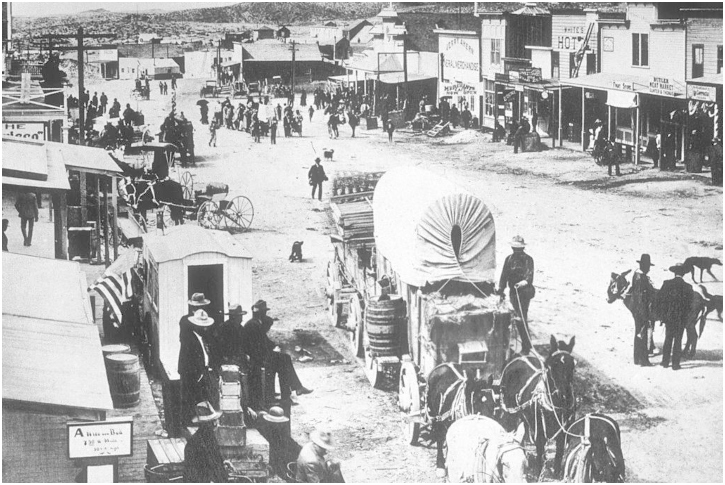 A throwback to the 1903 photo, it is a typical frontier town that offers everything that the towns of yore stood for. The picture is of a busy main street in the western settlement of Tonopah, Nevada.
A throwback to the 1903 photo, it is a typical frontier town that offers everything that the towns of yore stood for. The picture is of a busy main street in the western settlement of Tonopah, Nevada.
The town is the very picture of a bustling town, with the men bringing the things in the horse-drawn covered wagon brought goods to the trading posts. The people are either shopping away to glory, and some are going about their day. Everything is distinctive about this town, from what the people wear, their hats and their coats.
For The Love of Gold Rush
 Gold digging is every bit a hard task as much as it looks. Here, a few participants of the California Gold Rush are sifting through the water to get the gold.
Gold digging is every bit a hard task as much as it looks. Here, a few participants of the California Gold Rush are sifting through the water to get the gold.
Here, the river shown is the Snake River in Idaho, where you can find the hardest gold to mine. It is difficult to get the gold, and it is popular as flour or floats gold. This is a difficult loot to separate as you have to wean the precious gold from the not-so-useful. Here the men are going about their tasks with diligence.
Customers And Shopkeeper Lined Up In Front Of The Stores
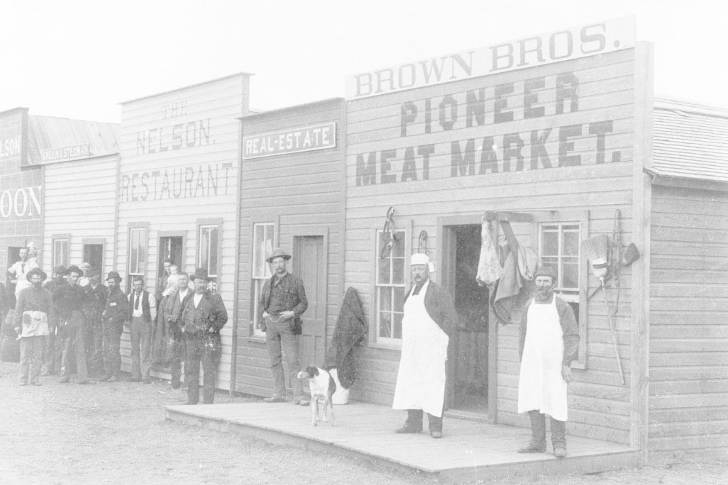 This photograph dates back to 1894, shows the shopkeepers and the customers lined up in front of their stores on Broadway Street in Oklahoma Territory’s Round Pond. Before the advent of the settlers, the nomadic Native Americans were the original inhabitants of this land.
This photograph dates back to 1894, shows the shopkeepers and the customers lined up in front of their stores on Broadway Street in Oklahoma Territory’s Round Pond. Before the advent of the settlers, the nomadic Native Americans were the original inhabitants of this land.
The Great Plains is split into two regions - The Indian Territory and the Oklahoma Territory. The town came into existence in the year 1893 and 8000 people started living in it. There was a hotel, quite a few restaurants, more than six grocery stores, two general stores, and law offices as well.
Women Learning How To Shoot From Annie Oakley
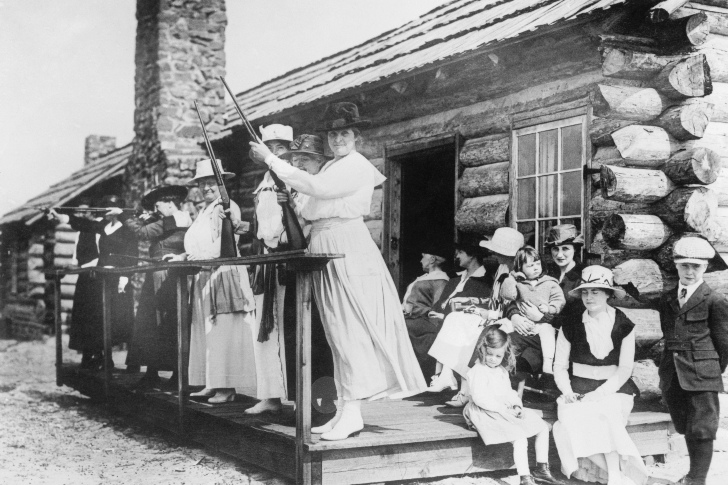 Annie Oakley always had the desire to teach sharpshooting to women. As this photograph from the year 1918 shows, she is teaching women how to handle a real gun. Since she lost her father when she was a child, she took the entire responsibility on her shoulders of feeding her family.
Annie Oakley always had the desire to teach sharpshooting to women. As this photograph from the year 1918 shows, she is teaching women how to handle a real gun. Since she lost her father when she was a child, she took the entire responsibility on her shoulders of feeding her family.
She started taking lessons in trapping and learned shooting and hunting by the age of 8. Annie always had a sharp eye and she decided to turn that talent into a business. There was no doubt that her business became immensely successful.
Barroom Dispute Back In Those Days
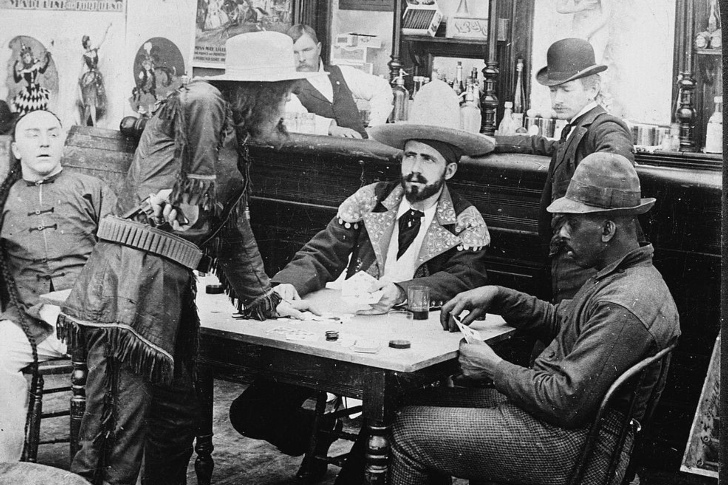 During the Klondike Gold Rush in the early 1900s, this is what a barroom scene would have looked like. Though it is a staged photograph, it’s not difficult to get an idea. A man wearing a cowboy hat and fringed leather jacket is holding a revolver and is busy arguing with a fellow gambler.
During the Klondike Gold Rush in the early 1900s, this is what a barroom scene would have looked like. Though it is a staged photograph, it’s not difficult to get an idea. A man wearing a cowboy hat and fringed leather jacket is holding a revolver and is busy arguing with a fellow gambler.
A brawl might break out and that has made other gamblers and drinkers around them stop whatever they were doing to focus on these two men. Money and drink always lead to trouble and brawls. That has been proven time and again.
Gold Hill Mining Camp
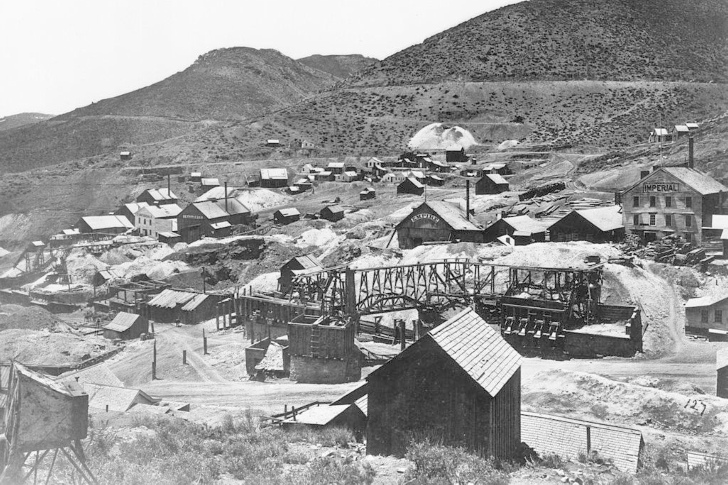
California’s Gold Hill was one of the sites where quartz gold was discovered. This photo that dates back to 1860 shows a part of the camp set up on the site. There is a story behind how gold was discovered here.
According to the Office of Historic Preservation, it was in October 1950 when George McKnight found out that his cow had escaped from its shelter and ran across this landscape. When McKnight took off after the cow to capture and bring her back, he stumbled against a rock that cropped out of the ground. It broke off easily and when McKnight examined it minutely, he found gold in it.
The Hidden Fortunes
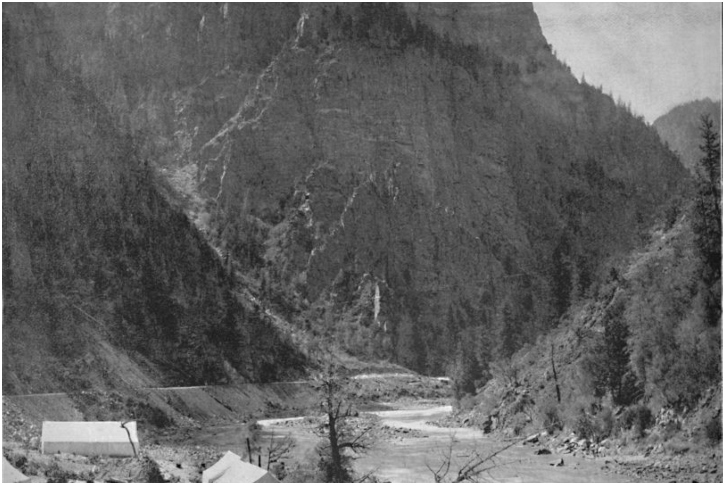
What does a mining camp in Nevada way back in 1897 look like? A picture here will give you an idea. Nevada was the location to go if you wanted to find North America's gold nuggets.
It was all about the gold but also the silver. The people in Nevada first struck silver in Comstock Lode in western Nevada, and soon people were able to win a large loot. No wonder it is also famous as the Silver State as it had large amounts of silver hidden there.
The Great Wild West Show
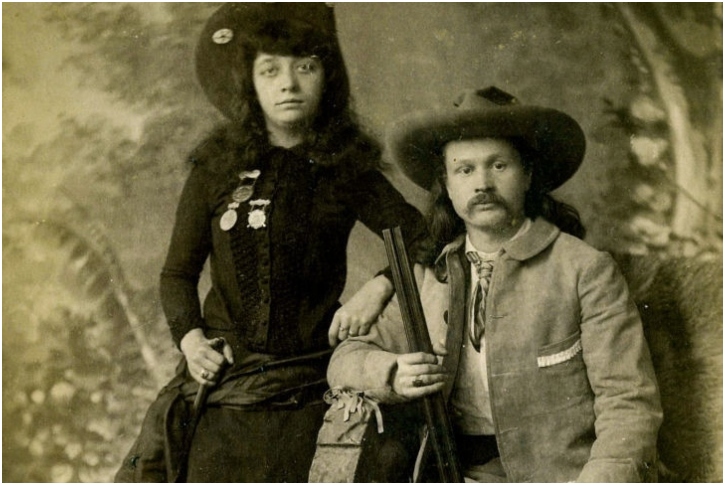
Pawnee Bill rose to fame when he teamed up with Buffalo Bill and was a regular feature in Bill's Wild West show. However, success soon followed him as he chose to branch out with his show, Pawnee Bill's Great Wild West Show.
He also walked down the aisle with May Lillie, who courted fame in her way as she was a celebrated sharpshooter and a competent horse rider. No wonder she earned the title of the greatest Lady Horseback Rifle-shot of the World. Truly, well-deserved, don't you think so?
Settlers Move To Their Farmhouse
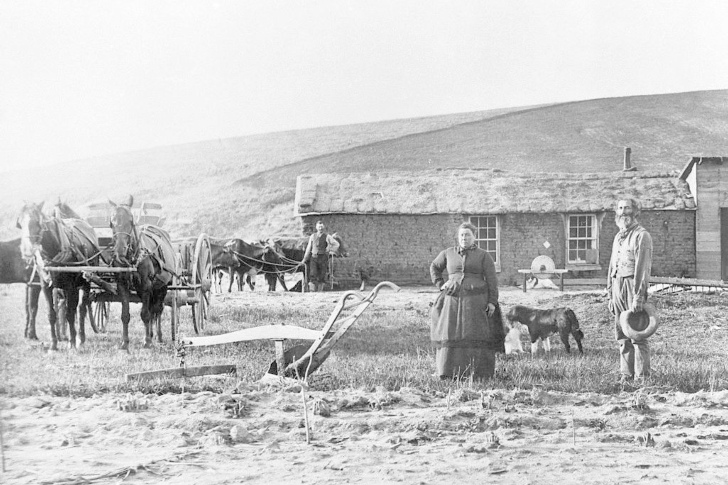 The Homestead Act, signed by President Abraham Lincoln in 1862, offered farms, each covering an area of 160 acres to citizens. They could live on those farms for five years. Settlers from Nebraska's Cluster County, as you can see in this photograph, migrated from the East with their animals to the frontier country.
The Homestead Act, signed by President Abraham Lincoln in 1862, offered farms, each covering an area of 160 acres to citizens. They could live on those farms for five years. Settlers from Nebraska's Cluster County, as you can see in this photograph, migrated from the East with their animals to the frontier country.
The government gave land at a very cheap price to more or less 400,000 families between 1862 and 1900. This propelled Western migration. However, this was terminated owing to the Taylor Grazing Act that President Roosevelt introduced in 1934.
Birthday Party In The Wild West
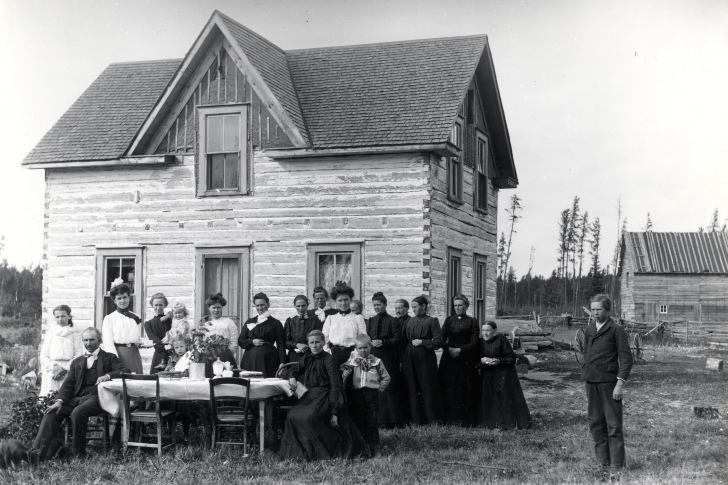 You are looking at a Frontier birthday party. This photograph dates back to 1900, most probably by a woman, since everyone at the party is a woman. The celebrations were happening outside and everyone looked happy and jovial.
You are looking at a Frontier birthday party. This photograph dates back to 1900, most probably by a woman, since everyone at the party is a woman. The celebrations were happening outside and everyone looked happy and jovial.
The table where the afternoon tea party took place was beautifully decorated with flowers. Not much information is available about the family shown in this snapshot, but it’s an easy guess that everyone was enjoying the afternoon to the fullest, indulging in food and laughter. The kids had a great time playing outdoor games.
The Bars of the Western Town
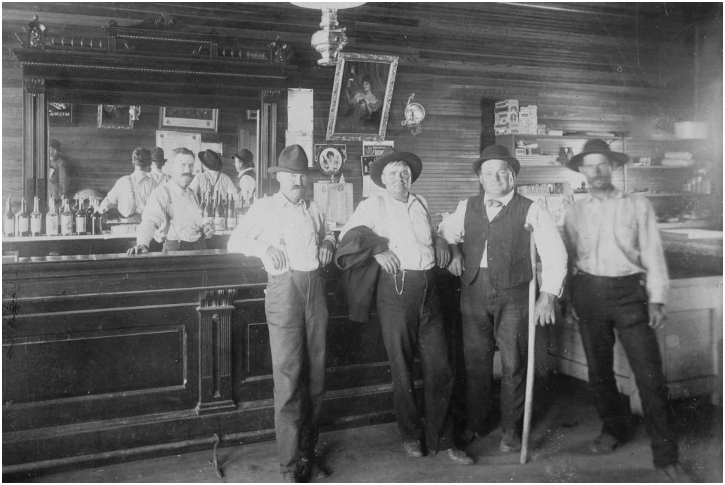 Like the bars of an unknown town in California in 1890. Just like any hip and happening bar, you see today, where men go about enjoying their drinks, guzzle their beers over some conversation and guffaws of laughter. Similarly, the Couple of Wild West cowboys are gathering around the bar right in the middle of an interesting conversation and not forgetting to pose for a photo in the middle.
Like the bars of an unknown town in California in 1890. Just like any hip and happening bar, you see today, where men go about enjoying their drinks, guzzle their beers over some conversation and guffaws of laughter. Similarly, the Couple of Wild West cowboys are gathering around the bar right in the middle of an interesting conversation and not forgetting to pose for a photo in the middle.
The bar stocks on the brands we drink today, such as Budweiser and Schlitz. The more things change, the more things remain the same, right?
Dashing Around the Outlet Race
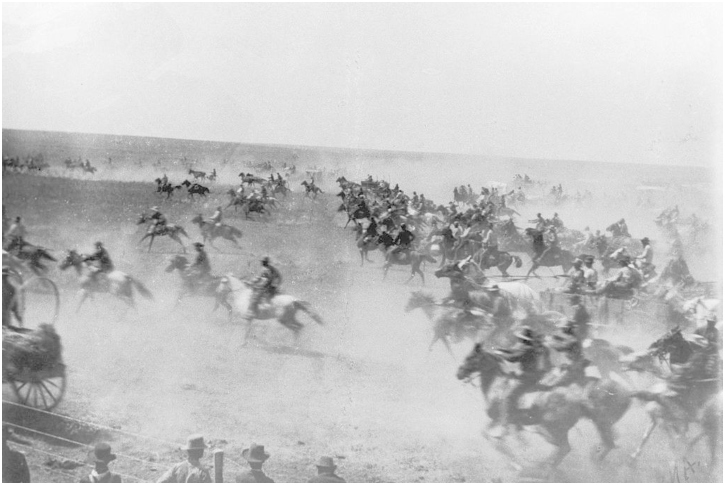
This photo is all about men and their beautiful horses moving at a break-neck speed blowing away the dust. This is a race in the Cherokee Outlet, just a few seconds after the gun went off.
It is a photo taken way back in 1893 and shows men riding their horseback on the field in Oklahoma. This is a picture from the Cherokee Outlet Opening, or the Land Run of 1893, which opened the Cherokee Outlet. It does make for a beautiful viewing and a spectacular sight!
Out and About the Grove
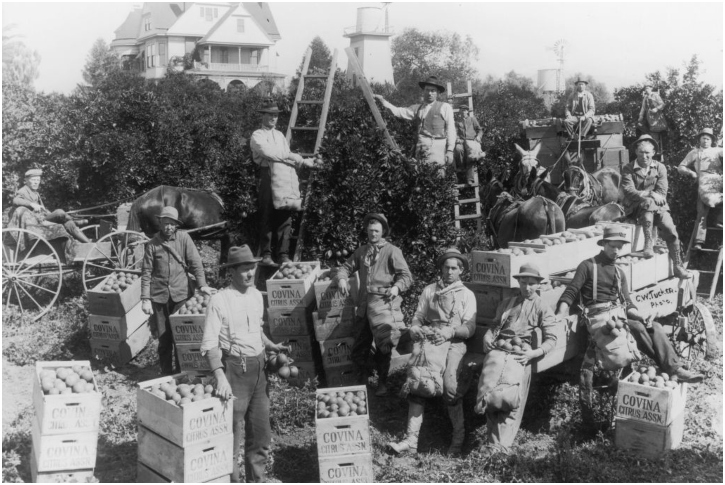
To everyone who thought that the Wild Wild West was only about men and their horses, well, this picture will tell you otherwise. Men also went about picking oranges from a bevy of orange groves.
This 1905 photo captures a couple of fruit pickers from the Covina Citrus Association in Southern California. Here they are shown strutting their stuff, picking up their haul from the orange grove, and their fruits of labor are for everyone to see. They are pretty proud of their ware. And the oranges do look fine produce.
Meandering Wagon Train
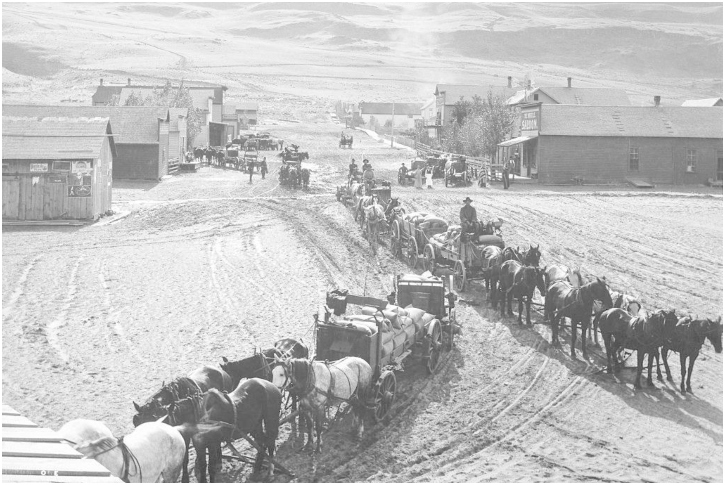
Growing vegetables in the Old West was quite difficult. This was because of the harsh conditions that stopped the crops from flourishing in the harsh conditions. This is a photo from 1880, which shows a wagon train driven by horses is laboring down the center of the town.
The farmers had to think about many things to make their crops grow. Irrigation was a problem. They had to use buckets to do the same. In fact, they even had to save their crops from hungry cows who would eat all the crops if let loose.
The Shod Shanty
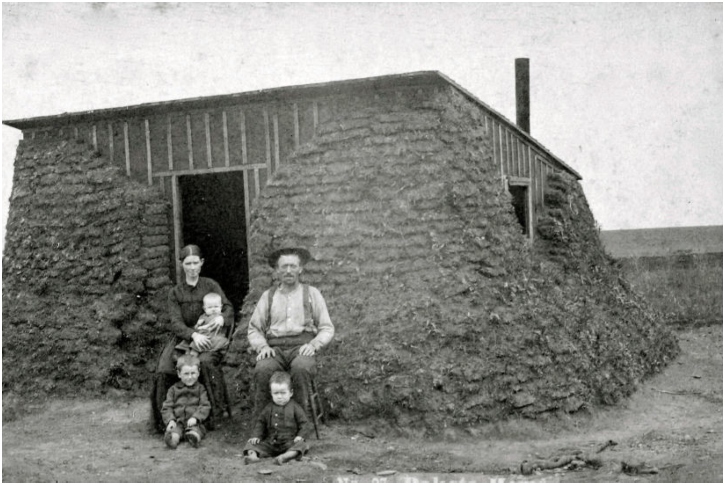
This image gives a picture of the Sod Santy way back in 1880 and 1890. Here a large family is posing and preening right outside their South Dakota house. The Sod Santies was truly iconic. They became a part of American folk songs by Oliver Edwin Murray.
The Little Old Sod Shanty On The Claim song was reminiscent of the bygone era. The song tells of the trials and tribulations of homesteading on the Great Plains and became extremely popular among the settlers. The song was recorded countless times. It just goes to show why it struck a chord among the settlers.
Ruffians On The Street
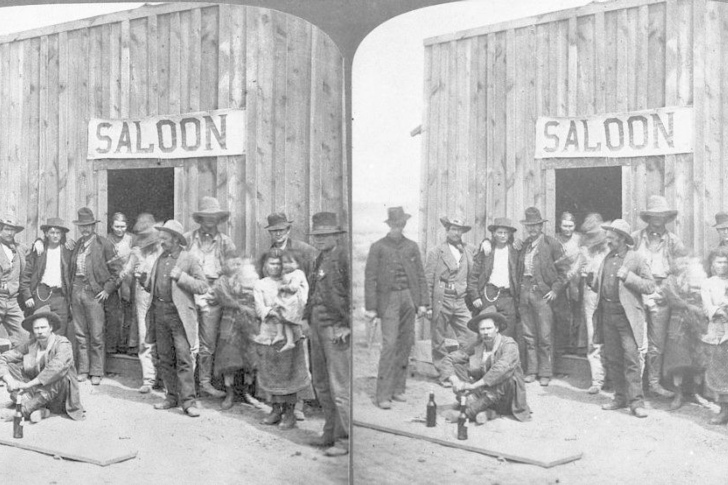 It’s hard to imagine a frontier town without ruffians. The twins in the frontier were full of saloons and tough men. This snap dates back to 1895. There is a cluster of men who have assembled in front of a saloon close to a railroad.
It’s hard to imagine a frontier town without ruffians. The twins in the frontier were full of saloons and tough men. This snap dates back to 1895. There is a cluster of men who have assembled in front of a saloon close to a railroad.
By looking at them, one can guess that they are either workers who are on a break from work or men who are waiting to get aboard a train to the new town coming up in the West. With that being said, though you can identify them as ruffians, they don’t look that threatening.
Publicity Photograph Of The Sharpshooter
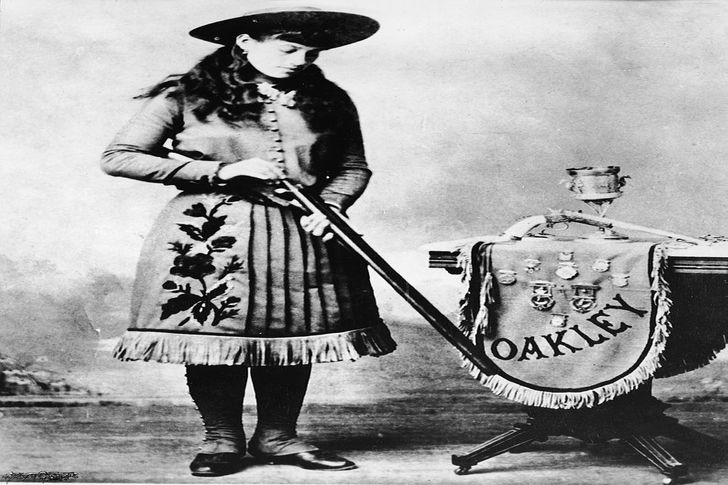 Annie Oakley, the popular sharpshooter, is treasured by the Americans. This snap dates back to the latter half of the 1800s. There is a table in front of her on which different marksmanship medals have been placed and Annie is standing right next to it, loading a shotgun. This is a snap used to advertise her brilliant performance in none other than Buffalo Bill’s Wild West Show.
Annie Oakley, the popular sharpshooter, is treasured by the Americans. This snap dates back to the latter half of the 1800s. There is a table in front of her on which different marksmanship medals have been placed and Annie is standing right next to it, loading a shotgun. This is a snap used to advertise her brilliant performance in none other than Buffalo Bill’s Wild West Show.
The outdoor western show, the first of its kind, was an adaptation of Buffalo Bills’ real-life adventures and was founded by Bill himself in 1883. Annie earned the distinction of winning her very first sharp-shooting match when she was just 15. Nothing could stop her from becoming a nationwide sensation later on.
The Gambling Hall
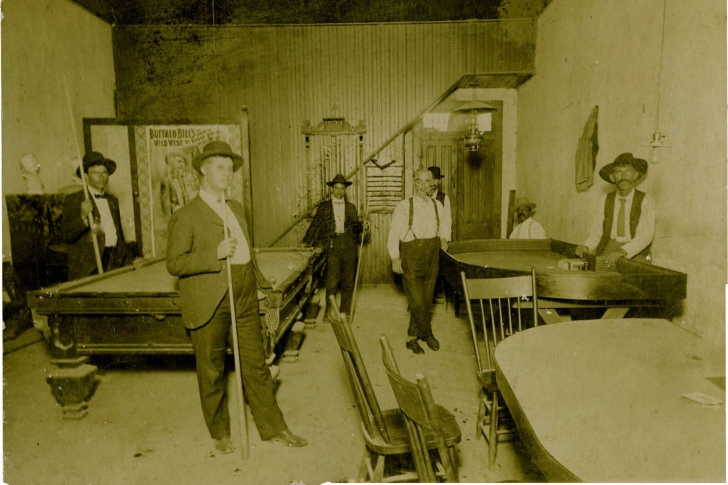 The Gambling Hall of the Wild West looked exactly like this. This is a 1915 snap of a saloon and a gambling hall. There is a pool table, a card table, a dice table, and a dealer having poker chips in front of him. Behind these men, there is a poster of Buffalo Bill.
The Gambling Hall of the Wild West looked exactly like this. This is a 1915 snap of a saloon and a gambling hall. There is a pool table, a card table, a dice table, and a dealer having poker chips in front of him. Behind these men, there is a poster of Buffalo Bill.
That seems to be an advertisement for the show named, The Congress of the Rough Riders of the World. When someone needed to unwind, escape from trouble, or win some money, this saloon and gambling hall was the perfect place to be.
The Cowboys

Though the Native American and African Cowboys have always been of major significance in the history of the Western territory, you won’t get many photos of them. This is a rare snap that was clicked between 1860 and 1870. One in four cowboys used to be of a colored complexion.
Just after the Civil War got over, men of color who didn’t want to take up jobs of delivery boys, elevator operators, or the like, had an inclination towards being a cowboy. According to a scholar researching African-American history, part of the job, they had to round up the cattle that had wandered away from the herd.
Pioneer Settlers

This photo from 1886 depicts a family of pioneer settlers standing next to their wagon. These covered wagons were made of wood to keep them lightweight. As horses were expensive, a majority of these settlers preferred oxen or mules to pull their wagons.
However, this family had horses pulling their wagon and that means they were quite well off. These settlers used to load these wagons with their belongings while migrating towards the West. But this looks empty. They might have just settled and might and are using it to roam around.
General John Charles Fremont
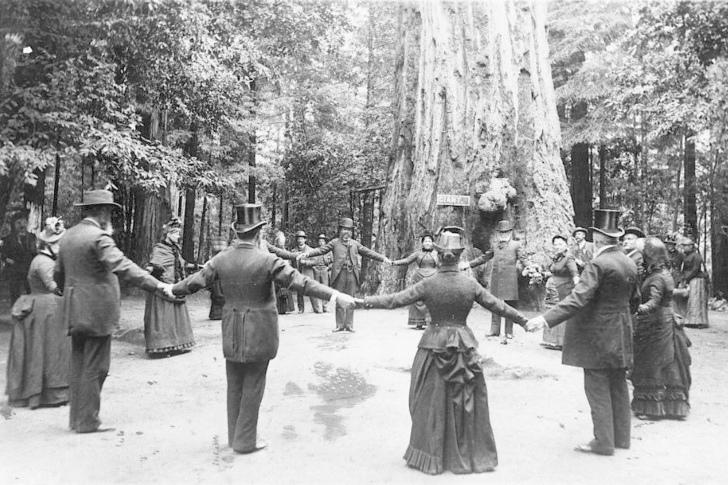
The American politician and explorer was a revered figure. He represented California as a senator and went to be the first candidate from the Republican Party to run for president in 1856. Gold was unearthed from his ranch during the California Gold Rush, thus making him a man of immense wealth.
This is an 1895 photograph where he is showing the size of the massive redwood trees to his wife, daughter, and friends in California’s Santa Cruz Grove of Big Trees. Everyone is standing in a circle to depict the circumference of the tree.
Life In The Frontier
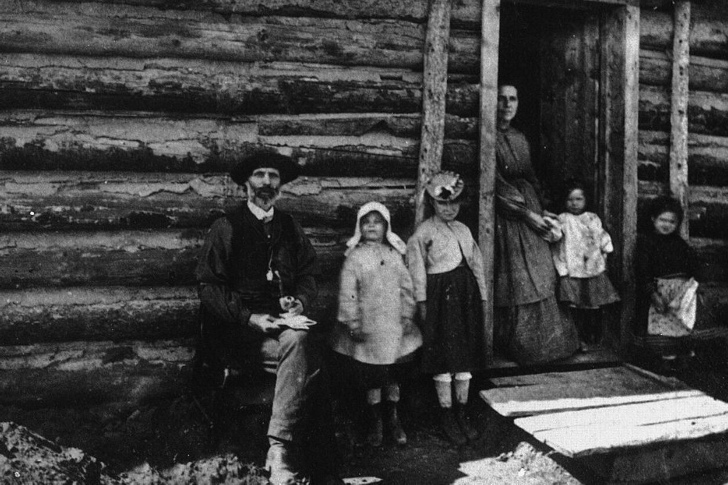 This portrait from the late 1800s depicts a family outside their home. The American West, a popular book, tells a tale of not only conquest but also of survival and the merging of people belonging to different places and cultures.
This portrait from the late 1800s depicts a family outside their home. The American West, a popular book, tells a tale of not only conquest but also of survival and the merging of people belonging to different places and cultures.
As the East Coast started getting overcrowded, people migrated towards the West. The land there was good for farming and was available at a cheap price. People who moved in started their life afresh and settled down with time. This family of six people is one of those that chose the West as their future habitat.
Claim Shack On The Great Planes
 If you have ever wondered what a claim shack might have looked like, this photograph from the early 1910s is an example you can refer to. These structures were used by homesteaders to lay claim on their farming land that covered a total area of around 160 acres.
If you have ever wondered what a claim shack might have looked like, this photograph from the early 1910s is an example you can refer to. These structures were used by homesteaders to lay claim on their farming land that covered a total area of around 160 acres.
To show others that particular land is under legal possession and no one else can farm or mine on it, landowners used to build these shanties in a hurry and walled them with tar paper. This shack was on the Great Planes of the Midwest.
Nostalgic Horse Rides
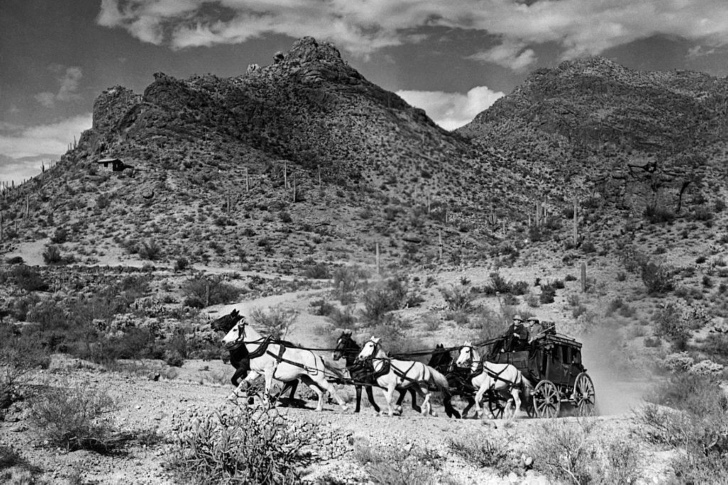 This snapshot has an amazing old world or retro-like feel, with the 6 horses pulling the stagecoach along rugged terrain. Back in those days, carriages or stagecoaches resembled buses and were meant for passengers who had to commute long distances.
This snapshot has an amazing old world or retro-like feel, with the 6 horses pulling the stagecoach along rugged terrain. Back in those days, carriages or stagecoaches resembled buses and were meant for passengers who had to commute long distances.
Long after carriages became popular, train engines, powered by steam became the common mode of transport. Of course, this picture takes us back in time, but the journey is truly an arduous one. Nevertheless, the picture has been captured well, especially the essence of nostalgia is well retained.
Racing Against Speed
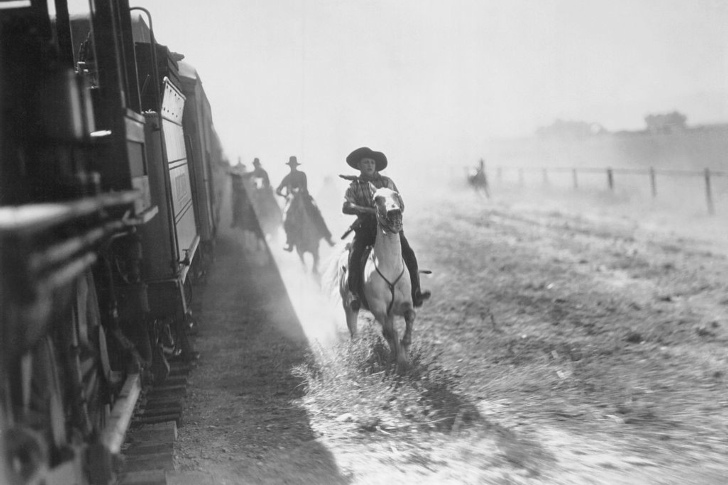 If there’s anything that stands out in this picture, it’s the expression of the horse, amidst the landscape where this photo has been captured. Anyone would make a journey into the land of cowboys and their adventurous streak, looking at this man and his team of horse riders.
If there’s anything that stands out in this picture, it’s the expression of the horse, amidst the landscape where this photo has been captured. Anyone would make a journey into the land of cowboys and their adventurous streak, looking at this man and his team of horse riders.
This is a picture taken from the Old Western, but we wouldn’t disagree if someone says it’s akin to a romanticized version of the Wild West. Knowing full well that keeping up with the ace of a train is no mean feat, but there’s a typical adrenaline rush riding horses trying to beat the speed of the train.
The Splendid Arizona Family
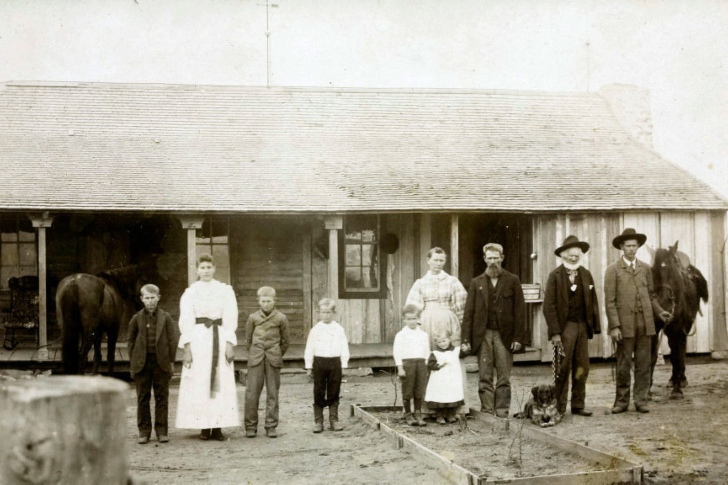 For a split second, this vintage picture might look scary- as if the last photo was clicked before their house! But that’s not the case. This snap dates back to 1890, wherein a rather influential family posed in front of their ranch in Arizona, near Elfrida. While no one knew what was their occupation, it’s widely assumed that they were farmers or cattle rearers.
For a split second, this vintage picture might look scary- as if the last photo was clicked before their house! But that’s not the case. This snap dates back to 1890, wherein a rather influential family posed in front of their ranch in Arizona, near Elfrida. While no one knew what was their occupation, it’s widely assumed that they were farmers or cattle rearers.
The picture is not candid, and everyone looks rather stoic. But the best part about the family was how they included their pets- dogs, and horse while the shot was taken. Elfrida now is a community that’s almost forgotten, but this family we bet will be remembered.
Mother And Son Before The Shack
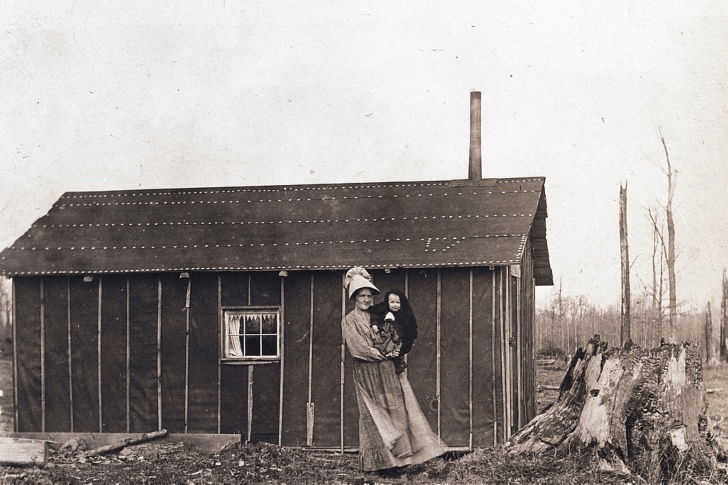 A cutesy click, this landscape however looks a bit too rugged and empty. Especially with no greenery around or most trees that have been chopped off- we wonder if the ay dynasty had attacked a community or tribe back then.
A cutesy click, this landscape however looks a bit too rugged and empty. Especially with no greenery around or most trees that have been chopped off- we wonder if the ay dynasty had attacked a community or tribe back then.
Still, this woman makes for a happy picture who poses with her cute little son before their home. One thing is certain- 1910 dated photo speaks volumes about the sad state of affairs characterizing these poor lives. We can merely hope that the child grew up to be a great man.
Calm Navajo Indian
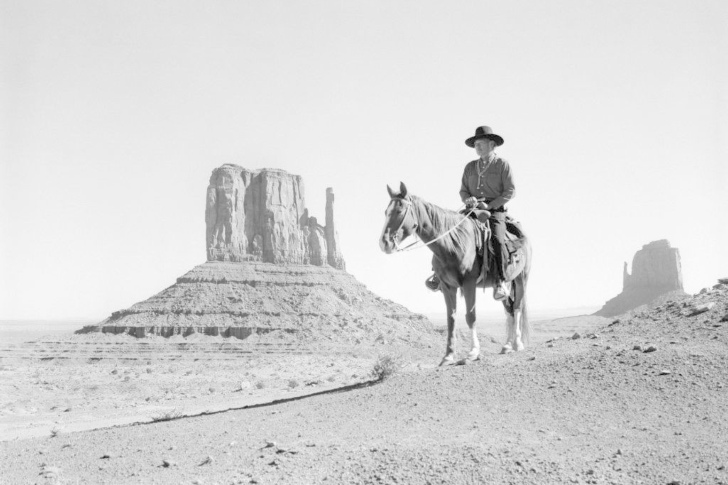 There should be no doubt that this is one of the finest photos to exist. Seems like a page torn from the history book. This photo reminds us of days when humans were afflicted by war. However, it’s a far cry from that! There is no revolver, no bullet, just a calm, patient man on a horse, against a picturesque view.
There should be no doubt that this is one of the finest photos to exist. Seems like a page torn from the history book. This photo reminds us of days when humans were afflicted by war. However, it’s a far cry from that! There is no revolver, no bullet, just a calm, patient man on a horse, against a picturesque view.
He’s a Navajo Indian who has posed net to the Monument Valley formations. If you didn’t know about Native Americans- they became pros in herding angry animals like buffaloes and worked hard to make a living. He’s one of them.
Pack Of Prospectors Looking For Gold
 A group of Americans in this picture posed with equipment since they wanted to trap some gold in the Northwest. If you are wondering how then this is a fact from 1867! The Discovery of gold in Eastern and Northern Washington pulled California prospectors towards the north. This infused the territory with a lot of successive developments and challenges.
A group of Americans in this picture posed with equipment since they wanted to trap some gold in the Northwest. If you are wondering how then this is a fact from 1867! The Discovery of gold in Eastern and Northern Washington pulled California prospectors towards the north. This infused the territory with a lot of successive developments and challenges.
While you look at them, their chivalrous attitude and spark can be visible enough. The vintage era is truly special, especially with the attire that people sported. This picture is no different either.
